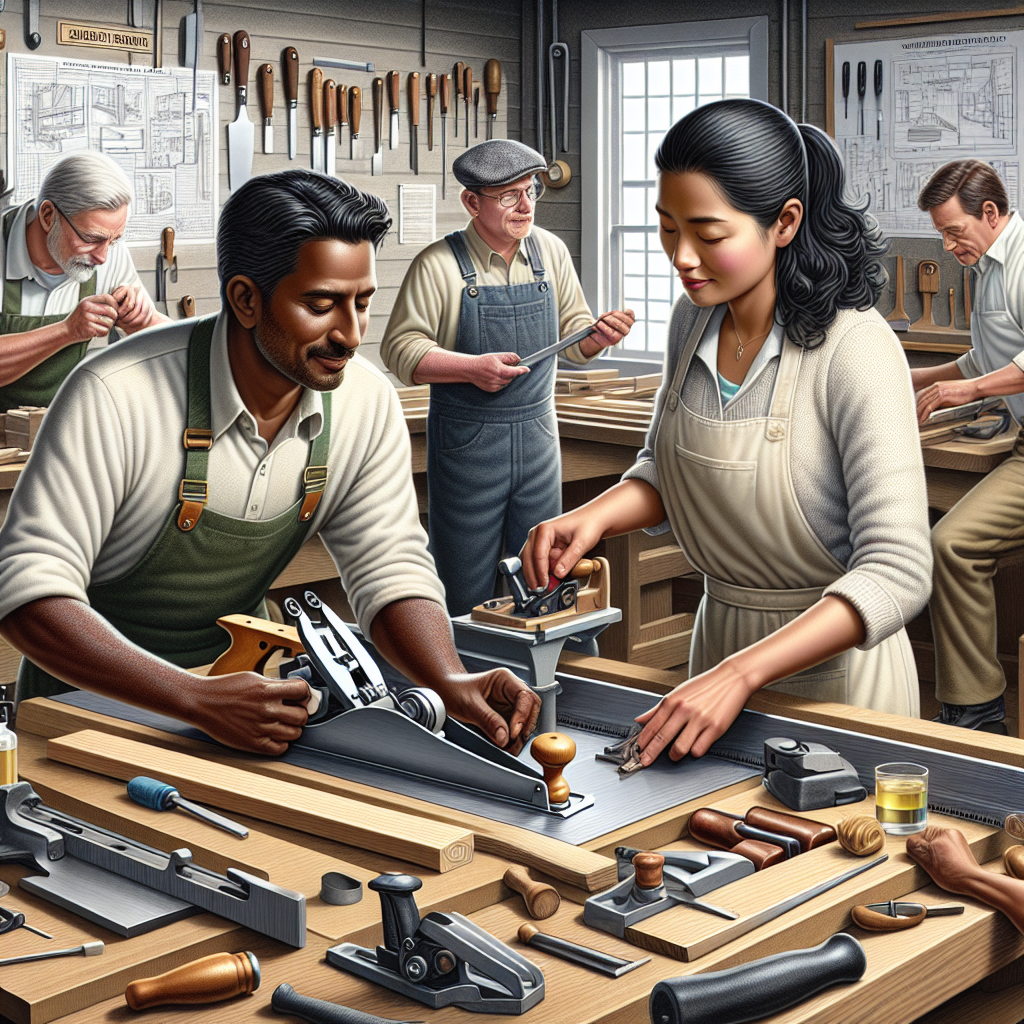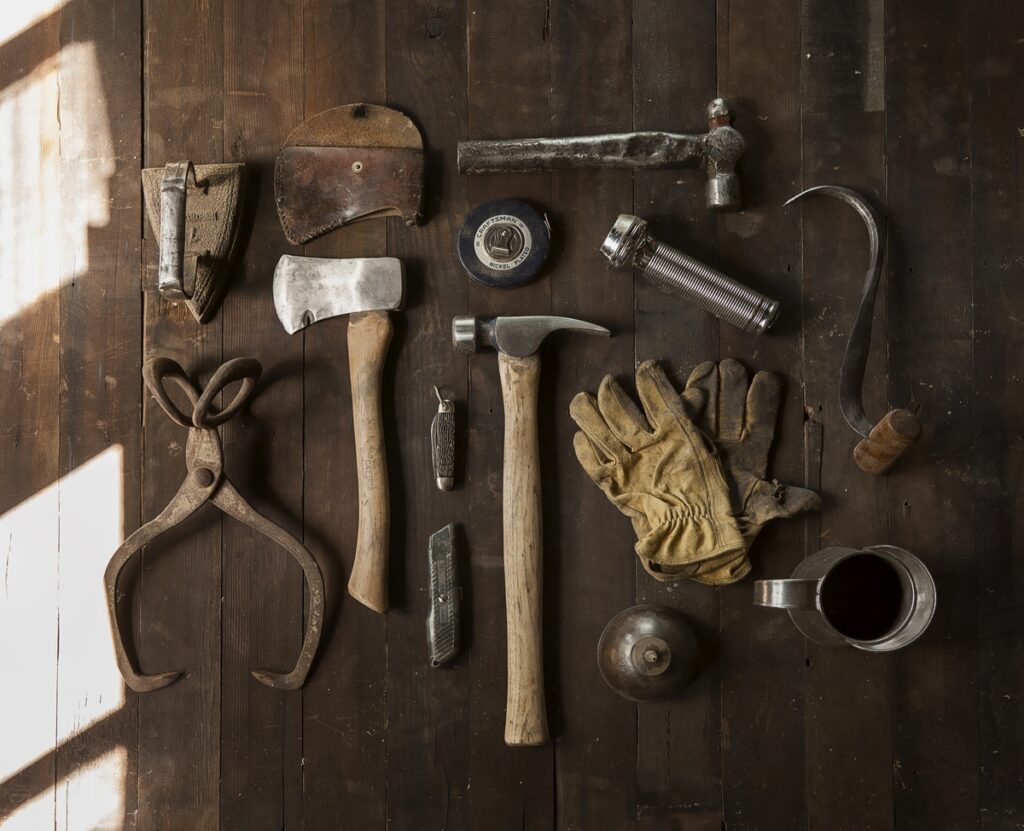
Introduction
Using hand tools safely is crucial for woodworking. From chisels and planes to saws, proper technique and precaution
prevent serious injury when using manual workshop equipment. Follow these 18 safety tips to foster
security in your woodshop.
Key Takeaways
- Always use sharp blades and well-maintained tools
- Secure your workpiece properly before operation
- Wear safety glasses and other PPE at all times
Manual tools empower intricate cuts and precision work a power tool cannot achieve. However, complacency around
common woodworking mistakes leads to
thousands of preventable accidents each year. Employing strict safety protocols while using hand tools is paramount
working smarter in woodworking.
Choosing the Right Tool
Blades & Bits
Chisels, planes, and saws depend on sharp cutting edges. Dull blades require excessive hand strength,
leading to poor control, inaccurate cuts, and hand tool injuries. Maintaining a razor edge through regular
sharpening and stropping alleviates these issues.
Chisels specifically ground for woodworking stay sharp longer than standard models. Opt for blade angles between
25-35°.
Many myths around sharpening and stropping hand tools get busted embracing woodworking
imperfections. For example, extra-fine strops and pastes polish edges without material removal helping
blades last weeks between stone sharpening.
Ergonomics
Ergonomic grips enhance control and reduce hand strain. While classic woodworking hand tools serve well,
innovative handles and knobs better support operation. This ergonomic focus extends to striking tools like mallets
and hammers. Materials like rubber or molded plastic provide improved grip over traditional wood handles.
Workstation Setup
Over 80% of hand tool injuries result from improper work holding. Set up a versatile workstation
accommodating both small and large stock. This provides appropriate control preventing accidents.
Vices & Clamps
- Install bench dogs securing round or irregular stock
- Utilize wooden hand clamps for unique shapes unfit for vices
- Add supplemental portable vices like Moxon
vices for specialized tasks - Use hold fast clamps and F-clamps to brace large panels
Avoid makeshift work holding contraptions which splinter sending projectiles towards the user.
While creative, these dangerous techniques harm woodworkers often.
Support
- Place sacrificial backup wood under the workpiece avoiding tear out
- Position support blocks before cut entry/exit preventing snipe
- Rest hands on bench during operation stopping accidental slips
- Secure small parts in a vise or clamp rather than holding the work in your hand
Cutting Direction
- Cut downhill or away from the hands/body
- Never cut towards other fingers or appendages
- Brace the body firmly to resist kickback forces
Cutting downhill requires lighter pressure, enhances accuracy, and avoids gouges from tool
deflection. Always plan operation direction before cuts start.
Personal Protective Equipment
Symbolizing craftsmanship and passion, many woodworkers use hand tools without basic protections risking safety.
Just like professional car mechanics don eye shields despite veteran experience, using PPE during hand tool
operation prevents trips to the emergency room.
Thousands of woodworkers suffer serious hand and finger injuries from improper safety precautions
The core PPE kit includes:
- Safety glasses guarding eyes from flying sawdust and debris
- Hearing protection shielding eardrums from high noise levels
- Respirators filtering microscopic dust from airways
- Cut resistant gloves prevent deep lacerations from sharp hand tools
Thick cut resistant gloves specifically designed for wood carving protect hands and wrists from gouges meeting
woodworking safety standards. Latex or
nitrile gloves add waterproof barriers avoiding skin irritation.
Tool Operation
With workspace properly configured, selecting hand tools commences transforming a workpiece. Follow operation best
practices preventing common or severe injury.
Grip & Stance
In addition to proper woodworking hand
tool grip, body stance matters.
Maintain solid stationary footing when executing
cuts. Avoid overextending body mass no matter
how beautiful the live edge slab
calls your name. Proper boring, chiseling, sanding, and sawing posture enhances control.

Keep feet shoulder width apart, brace core muscles, and avoid over extending on hand tool cuts
Tool Path
Deliberate and linear hand tool paths yield best results. Employ controlled movements with constant blade angles,
steady downward forces, and uniform depths. Rushing or erratic operation causes binding and injuries. Beginners
should practice precise tool guidance on scrap before tackling fine woodworking gift projects.
Mark cut lines tattooing workpieces. This prevents wandering. While master craftsmen work freehand,
visual indicators assist precision.
Preventing Recoil
Certain hand tools apply tremendous cutting forces. Incorrect handling allows equal reaction forces back towards the
hands.

- Grip tools tightly through contact awaiting mallet blows
- Check surroundings for obstruction before swinging mallet
- Secure workpiece avoiding movement energy transfer to hands/body
- Lean away and clear limbs from potential injury zones
Beginners should use light mallets despite temptation to grab durable framing hammers. Force
application requires practice. Upgrade striker weight once blade control skill progresses.
Adopt athletic ready positions like a lineman blocking an opponent.
Woodworking offers many parallels to competitive sports. Conditioning the body while also
concentrating mental focus results in elevated performance and safety. Do not neglect holistic training while
seeking woodworking inspiration
online.
Maintenance & Storage
Often disregarded following a projects completion, proper woodworking hand tool maintenance and
storage ensures availability next time inspiration strikes avoidable mistakes happen reconditioning rusted
groups found hiding around the shop.
- Clean all surfaces removing debris, sap, and residue
- Carefully sharpen edges or replace disposable inserts
- Lubricate sliding components preventing binding
- Store tools in an easily accessible case or chest
Well-organized tools encourage regular use while also protecting blades. Never leave sharp edges
exposed. Apply protective covers shielding cutting surfaces when not actively working better preventing
accidents.

Proper storage in protective cases maintains sharp chisel, plane, and saw edges.
FAQs
What are the most common hand tool injuries?
Deep lacerations to hands and fingers cause over 30% of accidents often needing stitches or surgery. Eye injuries
and contusions from flying debris make up an additional 40%.
Do injuries happen to both beginners and experts?
Yes. Complacency and fatigue contribute to mistakes even among seasoned veterans. Staying mentally engaged in the
present moment maintains best practices.
Is it really necessary to wear cut gloves and eye protection?
Absolutely. Nicks and punctures happen fast before you can react. Quality ANSI rated safety glasses provide 99%
protection from blindness and should be worn by everyone in a woodshop not just the operator.
Can injuries be avoided simply using sharp tools?
Partially. Honing blades assist cut precision but still require safe body mechanics. Assume kickback, binding, or
breakage can occur and preemptively protect hands/fingers from potential contact zones.
What are recommendations for protecting hands and fingers?
- Wear tight fitting nitrile gloves under cut resistant gloves
- Operate tools in tight vices whenever possible
- Use grip devices like push sticks to distance hands from blades
- Cut downhill away from hands and body
Is striking tools with a mallet more dangerous than blade tools?
Potentially. The heavy blows deliver tremendous force and precision grip is mandatory. Use a bench block to secure
chisels from movement allowing controlled strikes.
Should old style woodworking vices be upgraded to modern versions?
In many instances, yes. Quick release mechanisms, ergonomic handles, smoother jaw adjustments, and easier clamping
benefit all users helping stabilize workpieces. Consider capability before valuing charm.
Conclusion
Mastering hand tools expands creative potential through nuanced and delicate woodworking impossible power tools.
However, complacency leaves safety assumed. Committing to strict protocols like PPE use, correct tool selection,
stable work holding, athletic positioning, blade sharpness, clean operation, and orderly maintenance establishes
correct muscle memory reducing risk Suboptimal methods may work temporarily but jeopardize long-term well being.
Advancing from amateur to professional means recognizing then overcoming unsafe behaviors despite woodworking mistakes happening in positive community. Perfection is
unrealistic though excellence through preparation and protection creates profound beauty lifes imperfections
offer.

